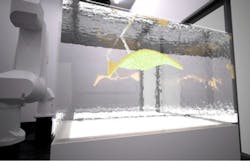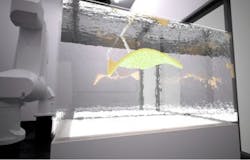New way to 3D-print: Suspend objects in gel
A novel 3D printing technique suspends light-curing resin in a gelatinous medium rather than using conventional structural support material during the build process. The gel acts as an omnidirectional support material and is reusable.
The technique is the brainchild of Brian Harms, who is still pursuing a Masters in Design Research at the Southern Calif. Institute of Architecture (SCI-Arc). The suspended deposition method he devised has yet to be commercialized, though that could happen in the future.
The suspended deposition prototype uses a Scara robot arm with a pump and extruding nozzle on its end effector. Once the material gets deposited in the gel, it is exposed to UV for curing. One interesting facet of this method is that the build material can be 'erased' any time before it cures simply by sucking it back into the nozzle. Another point to note is that material can deposit in 3D vector-based toolpaths. This contrasts with virtually all other 3D printing processes where successive layers must harden before the machine can move on to the next.
The fact that the resin sits in space without support material also makes it possible to fabricate directly on and around other objects sitting in the Gel. And the build material can sit in the gel waiting while the robot arm makes a tool change, injects a different material, or implements other changes that require a pause in the action.
Harms says he's just applied for a provisional patent covering the basic functions of the system in the context of rapid prototyping. "There may very well be patents on file that cover some of the aspects of the system," he says, "but in case there aren't, I decided it would be prudent to at least get a filing date."
Harms also calls the suspended deposition technique "purely an experimental endeavor" at the moment. He adds that he'd like to continue researching the idea but has no specific time frame in mind for commercialization. "There's a lot of work that would need to be done to make this process robust enough to become part of the 3D-printing market, and much of that would rely on funding," he says. "But we do have several ideas for improving the process both in terms of it's interface and physical set up. One of the most pressing issues would be the design of needle-tip attachments or articulated needle tips. This would help mitigate one of the major problems we face, which is the tendency for the resin to travel up alongside the needle as it passes through the gel, leaving a temporary void."
Accuracy and resolution is another issue. "Our needle is rather large and has an interior diameter a little larger than 1/16 inch. We haven't experimented much with any other sizes, but we think there is a lot of potential there," Harms says. "We are dealing with a liquid as opposed to a filament (which has a very consistent diameter) so we could actually actuate the needle opening, potentially allowing us to vary the resolution throughout the print."
Harms says the impetus for the project arose out of pondering how a robot would handle 3D printing. "The answer for us was articulation. A six-axis robot gives us possibilities for motion that the three-axis machines can't," he says.
Harms' first pump was a dual-nozzle, dual-centrifugal design created with the idea of handling multi-material injections simultaneously -- perhaps dispensing two-part resins that would only cure in the gel once the two parts had come in contact with one another. The idea didn't work well because the pumps put out too much material, even at their slowest settings. He ended up building his own peristaltic pump that is integrated into the tool.
Harms says the first items fabricated on the machine were a series of wireframe cubes chosen because they gave developers an idea of how changes in process parameters affected build quality. "For example, if we kept the flow rate constant but changed the speed of the robot, we would see the resin thin out as the robot sped up. So we used those objects as a way to calibrate the system," Harms says.
"We also created a series of spheres to show that while each was identical geometrically, it could be generated using very different toolpaths (which this system affords). One was built using vertical as opposed to horizontal contours, one was made using vertical radial arcs, and one was done in a continuous spiral," Harms says.
"We also printed a ring of resin that interlocked with a plastic ring that we had previously submerged in the gel. This was our sort of proof of concept for multi-material/multi-object operations," he relates.
Harms says the suspended deposition method will probably be limited to resins for the foreseeable future. "I think metals would be really tricky just given the temperature ranges you would have to deal with," he says. "I suppose if you were working with metals with really low melting points and you had a substrate that was incredibly insulative, you might be able to work that out. But that's just speculation at this point."
About the Author
Leland Teschler
Lee Teschler served as Editor-in-Chief of Machine Design until 2014. He holds a B.S. Engineering from the University of Michigan; a B.S. Electrical Engineering from the University of Michigan; and an MBA from Cleveland State University. Prior to joining Penton, Lee worked as a Communications design engineer for the U.S. Government.


